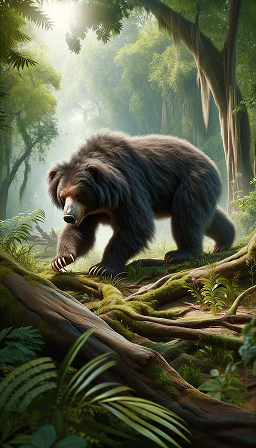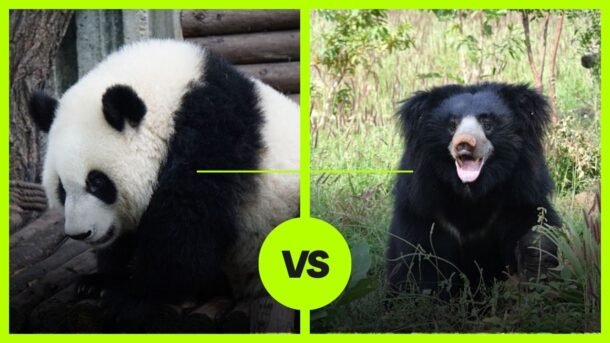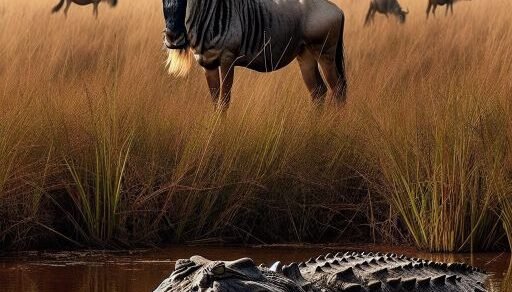Nature often produces battles that can only be described as unique and intriguing, as different species equipped with their specific traits and abilities confront each other in the battle for survival. In our series of hypothetical animal confrontations, the match-up of a giant panda versus a sloth bear presents one such extraordinary scenario. At a glance, the lumbering herbivore and the slow-moving omnivore may not seem like typical combatants. Yet both have attributes that could potentially make them formidable in a duel. Let’s delve into the characteristics, advantages, and tactics each would bring to the table in this unusual encounter.
Meet the Competitors
Giant Panda: The Bamboo Specialist
Endemic to certain mountain ranges in central China, the giant panda is primarily known for its love of bamboo, which makes up 99% of its diet. Adult males can weigh up to 85–125 kg (187–276 pounds) and possess a round body shape. Despite their somewhat cumbersome appearance, they have strong jaw muscles and a powerful bite force to crush bamboo stalks. They are generally peaceful but can display impressive strength and aggression when provoked.
Sloth Bear: The Termite Muncher

Native to the Indian subcontinent, the sloth bear is an unusual species of bear that specializes in consuming ants and termites. Adult males can weigh between 80 and 140 kg (176–309 pounds), and they are equipped with long, sharp claws for digging into termite mounds. Although not as powerful as other bear species, they are agile and can be quite aggressive when threatened.
Physical Attributes
Panda’s Powerful Bite and Strength
Though primarily herbivorous, the jaw structure of the giant panda is robust, giving it a powerful bite force that can easily crush bamboo—and potentially bone. Its heavy body and strong limbs would lend it considerable momentum in a physical altercation.
Sloth Bear’s Claws and Agility
The sloth bear’s most prominent features are its long, curved claws, which can act as effective tools for slashing. Additionally, despite its name, the sloth bear is more agile than it looks. It can run faster than a human and is capable of climbing trees.
In-Depth Look at Physical Strength

Giant Panda
- Muscle Power: Despite their peaceful nature, giant pandas have considerable muscular strength, primarily due to their size and the demands of crushing bamboo. This strength could be formidable in a conflict, offering the panda the ability to overpower many opponents.
- Endurance: However, their endurance is questionable. Pandas spend a significant portion of their day feeding and resting, which may not translate to sustained physical exertion in a fight.
Sloth Bear
- Powerful Limbs: Sloth bears, though not the largest of bears, have strong muscular limbs, vital for digging and climbing. This strength is more dynamic, potentially giving them an advantage in maneuverability.
- Resilience: As animals that actively forage and protect themselves from predators, sloth bears might have better physical resilience and sustained fighting capability compared to the more sedentary panda.
Combat Techniques Observed in Nature
Giant Panda
- Defensive Fighting: In the wild, giant pandas are solitary and generally avoid conflict. When they do fight, it’s mostly in a defensive manner, using their powerful jaws and sheer body weight. They may not have sophisticated fighting techniques but rely on their natural strength to fend off threats.
- Protective Mothers: Female pandas can be fiercely protective of their cubs, showing heightened aggression and strength when defending their offspring.
Sloth Bear
- Aggressive Confrontations: Sloth bears are more accustomed to defending themselves, especially against predators like tigers. They use their long claws and agility in combat, swiping at their adversaries and moving quickly to dodge attacks.
- Territorial Disputes: Males may engage in fights over territory or mates, using their claws and teeth in aggressive displays and physical confrontations.
Potential Conflicts in Nature and Their Dynamics
Scenario Analysis
- Territory Encroachment: In a hypothetical scenario where a giant panda and a sloth bear encounter each other due to overlapping territories, the initial interaction would likely be one of posturing and display. Pandas, being less aggressive, might try to avoid conflict unless cornered or if their cubs are threatened.
- Resource Competition: If the confrontation is over resources, such as a food source, the sloth bear might exhibit more aggressive behavior, using its agility and claws to assert dominance. The panda might initially try to stand its ground using its size and strength.
Real-World Confrontations
Pandas in Conflict: Real-world confrontations involving giant pandas are rare but can occur during mating season or territorial disputes with other pandas. These fights are usually brief, with the animals relying on their strength and loud vocalizations to assert dominance.
Sloth Bear Encounters: Sloth bears, facing more natural predators, are more adept at fighting. They have been observed standing their ground against larger predators, using their claws and surprising agility to defend themselves and their cubs.
Sloth Bear vs. Tiger: A Case Study in Survival Tactics
The sloth bear’s encounters with one of the most formidable predators in its habitat, the tiger, provide valuable insights into its defensive capabilities and combat strategies.
Survival Tactics Against Tigers
- Defensive Aggression: When confronted by a tiger, sloth bears display a remarkable level of bravery and aggression. Unlike their usual termite-hunting behavior, these bears can become fiercely combative.
- Use of Claws and Strength: Their primary defense mechanism involves standing their ground, using their powerful limbs and sharp claws to fend off attacks. Sloth bears are known to aggressively swipe at the tiger, aiming for the face and eyes.
- Protective Mothers: Female sloth bears with cubs are particularly aggressive towards tigers. They’ve been known to engage in life-threatening battles to protect their young, showcasing a surprising level of ferocity and resilience.
Combat Styles
Giant Panda’s Defensive Posture
Giant pandas are not aggressive by nature but can be fierce if they feel threatened. Their primary style of combat would likely be more defensive, relying on their body weight and powerful bite to deter attackers.
Sloth Bear’s Offensive Strategy
The sloth bear, in contrast, is known for its more aggressive disposition, especially when defending its cubs or territory. It would likely employ a more offensive strategy, utilizing its sharp claws in swiping motions and relying on its agility to dodge attacks.
Environmental Factors
Both animals are accustomed to forested and hilly terrains, though the panda prefers higher elevations. The environment may not provide a significant advantage to either, as both are adapted to similar ecological niches. However, the denser the vegetation, the more it may favor the sloth bear’s natural agility.
Conclusion: A Battle of Contrasting Strategies and Abilities
Both the giant panda and the sloth bear possess attributes that could give them an edge in a confrontation. The panda’s sheer body weight and powerful jaw could make it a formidable opponent, but the sloth bear’s agility and offensive tactics balance the scales.
Odds of Winning:
- Giant Panda: 55%
- Sloth Bear: 45%
Given the giant panda’s higher body weight and powerful bite force, it has a slight advantage in this hypothetical match-up. However, the sloth bear’s agility, swiping claws, and more aggressive nature make it a close contest. It’s a battle that would likely be hard-fought and could go either way, depending on a multitude of factors like first strike, positioning, and terrain. In this peculiar clash of forest dwellers, the outcome would be anyone’s guess, but we give a slight edge to the giant panda.
More to Read:
- Orangutan vs. Giant Panda: Delve into an imaginative showdown between the intelligent and agile orangutan and the calm, powerful giant panda, analyzing how these species might interact in a hypothetical encounter.
- Chimpanzee vs. Sloth Bear: This article presents a fascinating comparison between the intelligent chimpanzee and the robust sloth bear, exploring the dynamics of a potential encounter in the wild.




